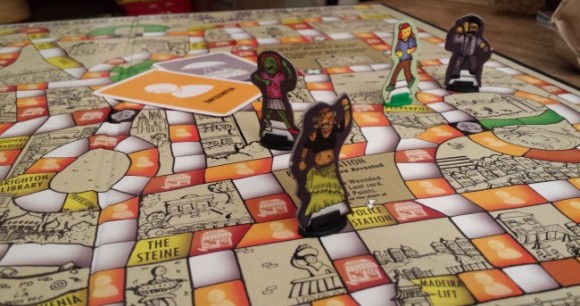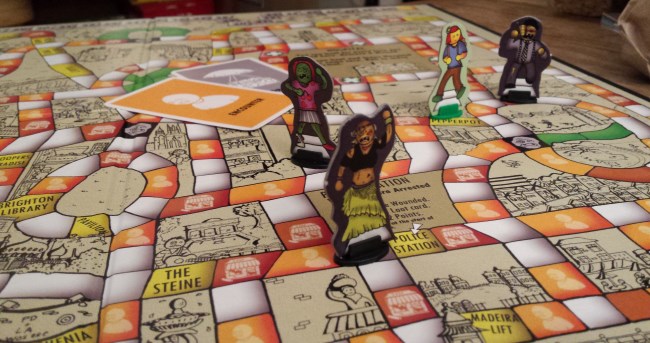
Over the past few years I’ve been watching, largely from the sidelines, the growth in popularity of board games. There’s clearly been a significant renaissance and from what I can see it’s a boom in sophistication of design and scope of imagination as well as pure audience numbers. Boardgames now appear in greater numbers at conventions and trade shows. I’ve heard of new boardgame shops opening and even new magazines – traditional print! – have been discussed. In January Quintin Smith (a games journalist whose focus has shifted increasingly toward board games) noted that he was being solicited for so much writing on board games that he has been turning down a lot of work each month. All told it’s clear that many people think this resurgence is more than a passing trend.
As usually happens when a bandwagon rattles by with things and people I like onboard, I’m intrigued enough to follow a little distance behind, picking up and examining the things that fall off the back. I’m not familiar enough with contemporary board games to offer informed opinions on them – unless you’re an expert blagger it’s difficult to fake expertise in specialist areas because the readership will rapidly suss you out – and if you’re not some sort of authority why would anyone be interested in reading you?
(For the record my answers to that are ‘I enjoy experimenting with writing about things I like’, ‘hell, I only started writing about video games in 2011, so let’s have a go’, and of course ‘what the hell, why not, and if the stats for this post are awful I’ll probably never do it again’.)
Boring crap about my freelance prospects aside, I, my girlfriend and many of our friends do enjoy playing board games and although the bulk of these are traditional word or party games (or modern spins such as Cranium) we’re slowly playing more of what, for lack of a better term and a lack of imagination on an overcast morning, I’ll just call modern board games. These have included games like Zombies!!!, Gloom, Saboteur, Pandemic but also my ancient copy of Doom of the Eldar. I’d love to introduce my girlfriend to Space Hulk one day, and reading reviews of games like Space Truckers leaves me positively excited at the prospect of playing them. Anticipation aside, though, we’re beginners in the world of modern board games.
Enter ZomBN1, a game made by local Brighton legend Paul Stapleton. It’s a zombie-themed variant on his Brighton-themed board game BN1. Paul’s been a feature of Brighton’s creative scene for years, largely producing comics (I’m particularly fond of Mr. Bethnal and Mr. Ongar, which stars a pair of ‘chav punks’ whose hobby is drinking awful cheap cider and ruining everything for everyone else), putting on gigs and heading up his band, Pog. BN1 was a departure for him but the reception to the game appears to have been broadly positive, and its success was enough to drive the creation of a horror-themed sequel.
It might seem risky to split your audience with two seemingly disparate themes – a board game all about one city with a small population, and the same place but with zombies – but Brighton is one of those kinds of city. We’ve had a large-scale zombie walk for years; the only reason 2014’s didn’t happen is because so many people were expected that it was cancelled for safety reasons. Plus Bedsit Press – Paul’s label-cum-distro-cum-business – has been producing only small print runs of these games. This does have the unfortunate side effect of copies being quite difficult to get hold of now, but I understand that additional print runs – and possibly revised editions – are planned for as long as there’s interest in the game.
Anyway, ZomBN1‘s a hybrid of traditional board games in which you simply move your counter around the board and modern affairs in which you fight off zombies (or other survivors) using a simple dice roll system, drawing encounter cards for random events and gather up loot, sneak and companion cards to improve your chances of survival. The ultimate objective is to achieve fifty points (by defeating zombies in combat or reaching objective locations on the board) and then reach the station to escape the city. Only one survivor can ultimately make it out, which seems a bit arbitrary but hey, it’s a competitive game.
To make matters worse for the luckless survivors, one player is in charge of the zombies, and they’re trying to achieve similar goals to you… by attempting to maim players (‘death’ means a survivor gets sent to the hospital and must sit there for a few turns) and overrun survivors’ objective locations with the undead horde.
Something that absolutely has to be noted about ZomBN1 is that it absolutely nails a slightly dark comedic tone. Brighton and its residents are lampooned across the board, pun intended, with fun being poked at the city’s various locations and its residents (such as one companion, a “30-year old holistic therapist and herb expert” who “won’t stop complaining about the impact the dead rising will have on local house prices”). Stapleton has been poking fun at Brighton for years, and while you get the sense he is driven to despair on occasion his tongue is firmly in his cheek and he’s having a lot of fun, well, poking fun.
In our first game of ZomBN1 there was an initial sense that the asymmetrical setup – human players competing with one another but also trying to beat the zombie player – was unbalanced. In the first half dozen to a dozen turns the human players were zipping around Brighton and scoring points with gleeful abandon. However, once the zombie player had gotten enough shambling undead on the board, and had begun to ‘kill’ survivors through weight of attrition, it became clear that this is a game of two halves. Survivors have the advantage early on; the late game is where the zombie player pulls into the lead.
We’ve yet to play enough games to determine whether or not ZomBN1 will prove balanced in the long run; whether this separation between early-game and late-game play offers enough scope for all player types to have a fair stab at victory. I have a good feeling about this so far, however, as despite the respective disparities in point-scoring there was still the sense, until a couple of turns before the very end, that a survivor could have come out on top. A lot of the zombie player’s biggest scoring moments came from incautious survivors going for broke, risking the zombie player scoring a lot of points by trying to fight past multiple zombies to reach objectives in a last, desperate run.
Although I don’t feel I am familiar enough with the field of board games to compare ZomBN1 against what’s out there as a whole, I can compare it to vanilla Zombies!!!, with which it shares more than a few structural as well as thematic ideas. As a Brighton resident I find ZomBN1 infinitely more characterful and amusing, and I can see that rotating the zombie player is likely to offer more longevity than the approach that Zombies!!! takes, but by the same token ZomBN1‘s static board layout isn’t going to provide any fresh surprises down the line. Comparisons aside, however, ZomBN1 was a lot of fun and will certainly be played again. At present my only real criticism is that its suggested playtime of 60-90 minutes is overly optimistic: for new players, twice that is more realistic.
[If any boardgame fans have any specific questions about ZomBN1 I’ll be happy to try and answer them in the comments.
I should add that the AR team discussed whether or not we should cover boardgames on AR – this piece was originally written with my personal blog in mind – and we ultimately decided that stuff like ZomBN1 is relevant enough to be of interest. If you’ve thoughts on this we’d also love to hear those – although we should emphasise that the focus of our coverage will, as for the last four years, continue to be PC, console and mobile games.]

Comments
One response to “Brighton Undead! A few thoughts on ZomBN1”
[…] much coverage of boardgames here on Arcadian Rhythms. In fact, looking back it seems I preceded my one board game review to date with a load of preamble about how we weren’t likely to cover them much because none of us really possessed a breadth […]